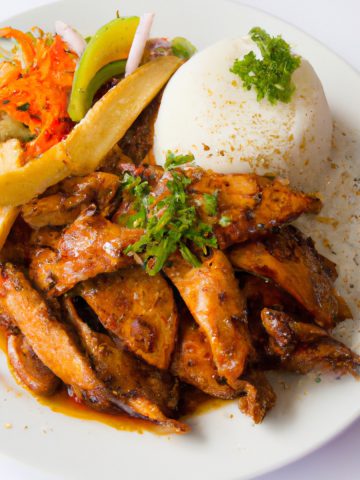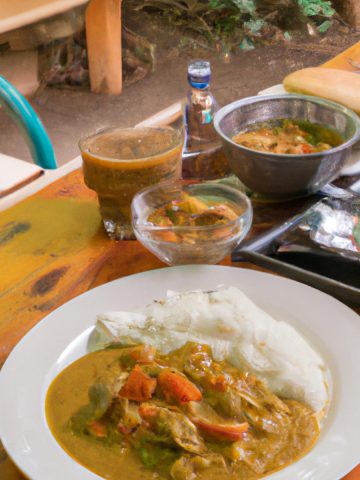
Jump to:
The moment you dig into this Osso Buco, you'll understand why I felt compelled to put my own unique twist on this classic Italian dish. Instead of sticking strictly to tradition, I've incorporated a blend of Asian-inspired spices to the recipe. The cumin, coriander, paprika, and a hint of turmeric work in harmony with the succulent veal shanks, aromatic veggies, and rich tomatoes, elevating this dish to a whole new level of deliciousness. It's a harmonious marriage of flavors that sings to your palate, leaving you with the kind of satisfaction only comfort food can bring.
But what really makes this Osso Buco special is the slow-braising technique. As you fill your home with the mouth-watering aroma that wafts from the oven, you're also tenderizing the meat to perfection. Each bite effortlessly pulls away from the bone, infusing your senses with an orchestra of flavors. The result is an irresistibly rich and hearty meal that pairs wonderfully with creamy polenta or crusty bread. So go ahead, roll up your sleeves and grab your Dutch oven. This is one culinary adventure you don't want to miss out on.
Why You'll Love This Recipe
Complex Flavors, Simple Execution: While the list of spices and ingredients may seem long, the actual steps are straightforward. You get a dish that tastes like it took all day, but without the fuss.
Impress Your Guests: This dish isn't just tasty—it's a showstopper. The veal shanks, with their bone-in presentation, make for a visually stunning meal that's perfect for special occasions or when you just want to treat yourself.
Comfort Food at Its Finest: There's something deeply satisfying about tucking into a bowl of slow-cooked, tender meat that's been braised to perfection. It's the kind of comfort food that soothes your soul.
One-Pot Wonder: Aside from the initial prep, this dish mostly cooks itself in one pot, meaning fewer dishes to wash and more time to enjoy your delicious creation.
How to Make Osso Buco
Making Osso Buco fills your home with irresistible aromas and results in a dish that's both delicious and visually appealing. Here's a step-by-step guide to help you craft this culinary masterpiece:
Preparing the Ingredients
- Preheat Oven: Start by preheating your oven to 325°F (163°C).
- Season and Dredge: Generously season the veal shanks with salt and pepper, then dredge them in flour, shaking off any excess.
Cooking
- Brown the Veal: Heat 2 tablespoons of olive oil in a large Dutch oven over medium-high heat. Add the veal shanks and brown them on all sides until golden. This should take about 5 minutes. Remove and set aside.
- Sauté Veggies: In the same pot, add the remaining olive oil and sauté the onion, carrots, celery, and garlic until they soften, about 5 minutes.
- Add Spices: Combine cumin, coriander, paprika, turmeric, and optional cayenne pepper in a small bowl. Add this spice blend to the pot, cooking for an additional minute to toast the spices.
Deglazing and Simmering
- Deglaze: Pour in the white wine and scrape the pot's bottom to deglaze, loosening any browned bits. Let the wine simmer for a couple of minutes to reduce slightly.
- Add Remaining Ingredients: Stir in the diced tomatoes, beef or vegetable broth, bay leaves, and lemon zest.
- Return Veal: Put the veal shanks back into the pot, making sure they are mostly submerged in the liquid.
Braising
- Oven Time: Cover the Dutch oven and transfer it to the preheated oven. Braise for 2 to 2.5 hours, or until the meat is tender and easily pulls away from the bone.
Final Touches
- Remove and Discard: Carefully take the veal shanks out of the pot and place them on a serving platter. Discard the bay leaves.
- Taste and Adjust: Optionally, skim any excess fat from the sauce and adjust the seasoning if needed.
- Garnish and Serve: Spoon the sauce over the veal shanks and garnish with chopped parsley. Serve hot, ideally with a side that will soak up the wonderful sauce.
Substitutions for Osso Buco Ingredients
In my years of cooking, I've found that flexibility can be a home cook's best friend. Whether you're working around dietary restrictions or simply dealing with an under-stocked pantry, here are some reliable substitutions for your Osso Buco adventure:
Veal Shanks: If you're not a fan of veal or it's not readily available, you can easily replace it with beef or pork shanks. Just adjust the cooking time as needed, as these meats may have different textures and densities.
White Wine: If you're avoiding alcohol, you can opt for chicken or beef broth instead of white wine. For a zesty kick, I sometimes add a splash of white wine vinegar or apple cider vinegar to the broth.
Aromatic Vegetables: If you're out of onions, carrots, or celery, consider using leeks, shallots, or even fennel. I find these add a unique but delicious twist to the traditional flavor profile.
Broth: Whether the recipe calls for beef or vegetable broth, you can usually interchange them without dramatically altering the dish. Chicken broth can also step in as a mild, versatile option.
Tips and Tricks for Perfect Osso Buco
Dredging: The step of dredging the veal shanks in flour serves a dual purpose. First, it helps create a beautiful golden crust when you brown the meat, which adds flavor. Second, the flour works as a mild thickening agent as the dish simmers, contributing to a rich and velvety sauce. Shake off excess flour to avoid clumps.
The Art of Browning: Browning is not just about changing the color of the meat; it's a flavor-building step. Use medium-high heat and give each side of the shank time to develop a deep, golden crust. Also, avoid crowding the pan, as this can cause the meat to steam rather than brown, depriving you of that extra layer of flavor.
Deglazing Mastery: Deglazing the pot serves to collect all the delicious, caramelized bits from the bottom. Make sure to use a wooden spoon to scrape these bits free as you add your liquid. This is where the wine, or broth if you're substituting, really shines. Allow the liquid to simmer and reduce slightly; this concentrates the flavors.
Submerging and Cooking: Before you transfer the pot to the oven, double-check to make sure the veal shanks are mostly submerged in the braising liquid. This ensures even cooking and a moist, tender result. If the liquid level seems low, don't hesitate to top it off with a bit more broth or even water. The long cooking time will meld the flavors regardless.
Skimming and Adjusting: Once your Osso Buco is cooked, you'll often find a layer of fat on top of the liquid. While some prefer to keep it for richness, you might want to skim it off for a lighter sauce. Use a flat spoon to carefully skim off the fat layer, then taste your sauce. Adjust the seasoning if needed, as the flavors can change during the cooking process.
Storing, Freezing, and Reheating Osso Buco
Storing Leftovers
- Refrigerator: Store any leftover Osso Buco in an airtight container in the refrigerator for up to 3-4 days. The sauce thickens and flavors meld, often making it even better the next day.
- Separate or Together: You can choose to store the meat and sauce separately or together. Storing them together allows the meat to soak up more flavor as it sits.
Freezing for Later Use
- Cool Completely: Before freezing, make sure the Osso Buco has cooled completely. This helps prevent the formation of ice crystals that could affect the texture.
- Portioning: Consider portioning the meat and sauce into individual or family-size servings. This makes it easier to reheat only what you need.
- Packaging: Use airtight containers or heavy-duty freezer bags to minimize freezer burn. Label them with the date, so you know when to use them by.
- Freezer Time: Properly stored, Osso Buco can be frozen for up to 2-3 months.
Reheating
- From the Fridge: If stored in the refrigerator, you can reheat Osso Buco on the stove over medium-low heat. You may need to add a small amount of water or broth to loosen the sauce. Heat until it reaches an internal temperature of 165°F (74°C).
- From the Freezer: For best results, thaw frozen Osso Buco in the refrigerator overnight. Reheat using the same method as above. If you’re in a hurry, you can also reheat it straight from the freezer. Cover the pot and use a low heat setting, stirring occasionally, to ensure even reheating.
Recipe

Osso Buco
Equipment
- Large Dutch oven or heavy-bottomed pot with a lid
Ingredients
- Salt and freshly ground black pepper to taste
- ½ cup all-purpose flour for dredging
- 4 tablespoons olive oil divided
- 1 large onion finely chopped
- 2 carrots finely chopped
- 2 celery stalks finely chopped
- 4 garlic cloves minced
- 1 teaspoon ground cumin
- 1 teaspoon ground coriander
- 1 teaspoon paprika
- ½ teaspoon turmeric
- ¼ teaspoon cayenne pepper optional, for heat
- 1 cup dry white wine
- 1 can 14 ounces diced tomatoes, with juices
- 1 cup beef or vegetable broth
- 2 bay leaves
- Zest of 1 lemon
- 2 tablespoons chopped fresh parsley for garnish
Instructions
- Preheat your oven to 325°F (163°C).
- Season the veal shanks generously with salt and pepper. Dredge them in flour, shaking off any excess.
- Heat 2 tablespoons of olive oil in the Dutch oven over medium-high heat. Add the veal shanks and brown them on all sides until golden brown. This should take about 5 minutes. Remove the shanks and set them aside on a plate.
- In the same pot, add the remaining 2 tablespoons of olive oil. Sauté the onion, carrots, celery, and garlic until they soften and become translucent, about 5 minutes.
- In a small bowl, combine the ground cumin, coriander, paprika, turmeric, and cayenne pepper (if using). Add the spice mixture to the pot and cook for an additional minute to toast the spices and release their flavors.
- Pour in the white wine and scrape the bottom of the pot to deglaze, loosening any browned bits. Let the wine simmer for a couple of minutes to reduce slightly.
- Add the diced tomatoes with their juices, beef or vegetable broth, bay leaves, and lemon zest to the pot. Stir well to combine.
- Return the veal shanks to the pot, nestling them into the liquid. The shanks should be mostly submerged. If needed, add a bit more broth or water.
- Cover the Dutch oven with the lid and transfer it to the preheated oven. Allow the Osso Buco to braise for 2 to 2.5 hours, or until the meat is tender and easily pulls away from the bone.
- Once cooked, carefully remove the veal shanks from the pot using tongs or a slotted spoon, and place them on a serving platter. Discard the bay leaves.
- If desired, skim any excess fat from the surface of the cooking liquid. Taste the sauce and adjust the seasoning with salt and pepper, if needed.
- Spoon the sauce over the veal shanks and garnish with chopped fresh parsley.
- Serve the Osso Buco hot, accompanied by creamy polenta or crusty bread to soak up the delicious sauce.
Nutrition
Osso Buco - FAQ
Absolutely! For a slow cooker, follow all the initial steps up to browning and then transfer everything to your slow cooker. Cook on low for 6-8 hours. In an Instant Pot, you can use the sauté function for browning and then switch to the pressure cook setting for about 45 minutes on high pressure.
While wine adds a nice depth of flavor, you can substitute it with beef or chicken broth. Some people also use apple cider or a mixture of vinegar and water for tanginess.
If your sauce is too thin after cooking, you can remove the meat and simmer the sauce on the stovetop until it reduces to your desired consistency. Alternatively, you can make a quick roux with flour and butter and stir it into the sauce.
Yes, Osso Buco actually tastes better the next day as the flavors meld. Simply reheat it gently on the stove, adding a bit of broth or water if needed.
Traditional sides include creamy polenta, risotto, or crusty bread. Vegetables like steamed asparagus or a simple green salad also work well.
It’s a matter of personal preference. Skimming the fat will result in a lighter sauce, but if you prefer a richer flavor, you can leave it.
Chopped fresh parsley is traditional, but you can also use other fresh herbs like thyme or basil. Some people also like to add a sprinkle of freshly grated Parmesan cheese.

















Comments
No Comments